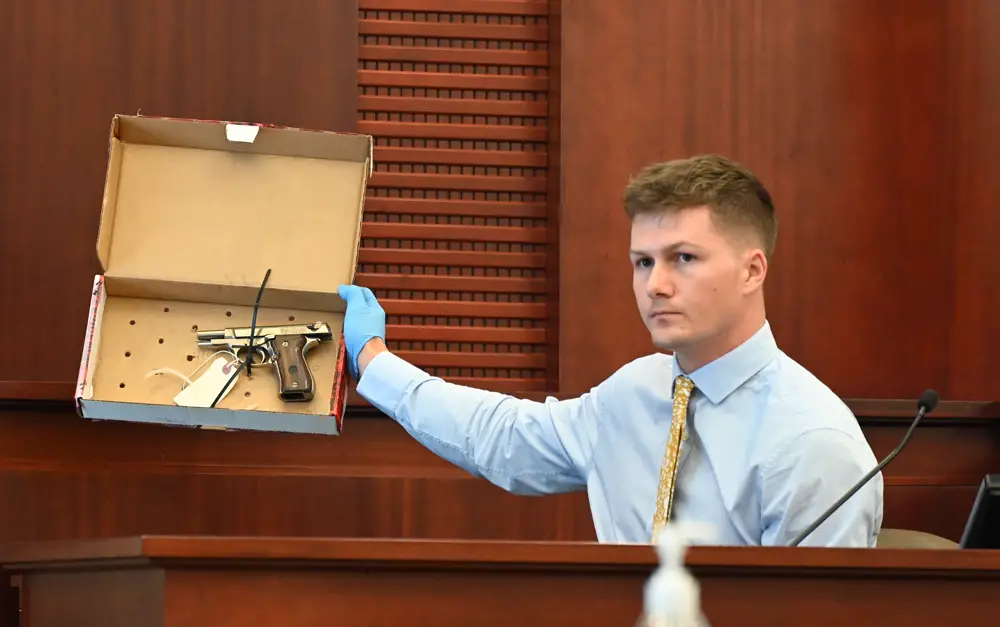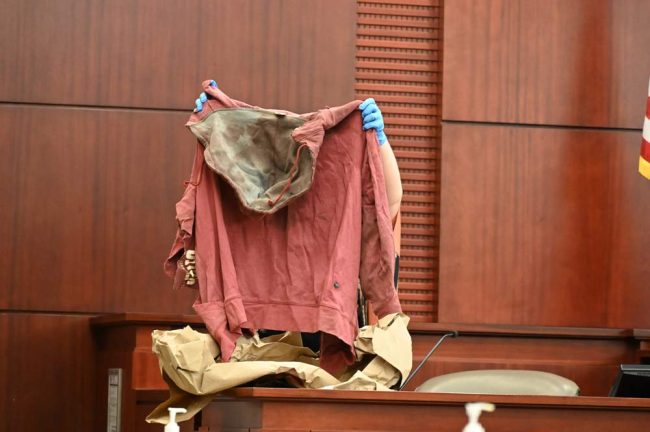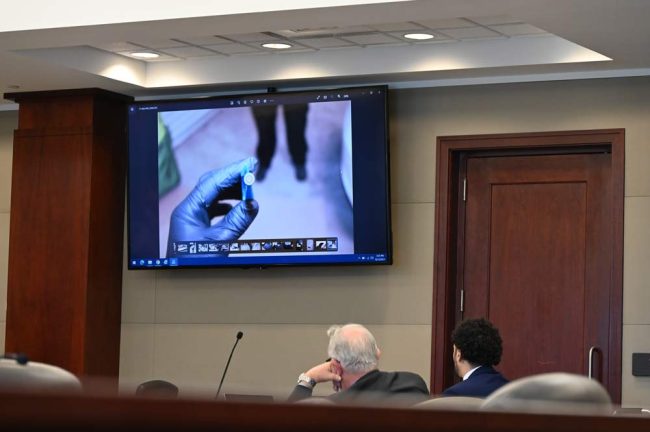
The prosecution today presented a daylong procession of forensic evidence surrounding Brenan Hill’s shooting of Savannah Gonzalez in Palm Coast in March 2021. It included the silver gun he used–the gun he bought 48 hours before–then hid in shrubbery beds in the outer rim of the Publix shopping center on Belle Terre Parkway, immediately after the shooting.
The day had its emotional moments, to the extent that even inert objects can trigger wrenching reactions, as when a witness unwrapped and displayed, one after the other and out of the crude brown bags that typically seal evidence, the clothes Savannah wore that day–her dark-pink sweatshirt, darker in spots near the hoodie, the black Burger Bros t-shirt she wore, representing her place of work in that same shopping center, the pink and black sports bra she wore beneath.
The day’s evidence also included numerous photographs, including 58 of the crime scene, Hill’s white Honda, of the blood on parts of the car, especially on the driver’s side door, and some of Savannah herself–those shown only the jury–unconscious in a hospital bed, after the shooting.
But there was no smoking gun. None of the evidence would have bothered the defense much. None of it contradicted the argument defense attorney Gerald Bettman presented to the jury in his opening: the prosecution is right. There was a shooting. Hill did it. He was unloading or “de-cocking” his gun in the car with Savannah next to him. The gun went off accidentally. The bullet struck Savannah in the back of the head. Where in the back of the head remains in dispute, though that dispute may be put to rest Thursday, when the medical examiner testifies. He hid the gun. He lied about the shooting, blaming a Black man who never existed. He lied, Bettman argued, only because he panicked and was scared to tell police what happened.
The prosecution doesn’t buy it. He lied, Assistant State Attorney Melissa Clark argued, because he shot Savannah, who was 22, as a result of his “short fuse” and abusive history toward women. Savannah wasn’t the only one he’d hurt. Just the only one he killed, accidentally or not.
But nothing in the testimony the 10 witnesses the prosecution questioned today–all of them law enforcement, detectives, crime scene investigators, commanders, all but one of them current or former employees of the Flagler County Sheriff’s Office–provided more than technical information. It was neither exculpatory nor incriminating, at least not to the measure of the most serious charge Hill faces: second degree murder, which could result in a minimum mandatory prison sentence of 25 years on conviction, and up to life in prison. He is 34.
In that sense, it was almost a good day for Brenan Hill, especially in comparison with Tuesday. It was a good day because the jury didn’t once hear his voice, as it had for much of the day on Tuesday. Just about all the jury heard out of Hill’s mouth on Tuesday were lies. A sustained odyssey of lies to deputies and detectives who’d recorded it all and who, at first–but not for long–thought he was telling the truth, that he and Savannah had been the victim of a robbery. He’d also lied to his mother, to a 911 dispatcher, to medical staff, though the jury didn’t hear those parts, which are in evidence in court documents that haven’t made it into the evidence pile.

The prosecution’s witnesses today were lined up in a way to chronicle Hill’s and Savannah’s last hours almost step by step, mile by mile, from the time they checked out of the Microtel–a housekeeper there testified about that at the end of the day Tuesday–to the time when Hill’s gun was found that night, where he’d hidden it. The testimonies were also a broad window into the Flagler County Sheriff’s vastly more technologically reliant policing. The agency now has some 30 license plate readers around town. It had 20 at the time of the shooting. Between those and other surveillance cameras the agency taps into, Hill’s itinerary was reconstructed, with video and images, from the time it left the hotel.
When Hill briefly stopped at Burger Bros, where Savannah was supposed to work, a co-worker testified to seeing them arguing–and said two months earlier Savannah had reported to work with a black eye, allegedly from Hill. A SnapChat video Hill took of himself the night before shows him showing off his new gun. CSI investigators testified to the numerous pictures they took of the car and of Graham Swamp, where Hill had sent police on a false trail, claiming falsely that that’s where the bogus robbery had taken place. The evidence technician who’d processed the car and Savannah’s clothes spoke about that, showing all the clothes and the blood she tested in five spots around the car. Several detectives filled in details, correcting his lies with what they turned up.
Still, those lies aside, none could authoritatively say that the gunshot was intentional, because none could read that science, as Bettman sought to show the jury by asking almost every witness the same questions.
Bettman put to work a commonly used tactic among defense attorneys: asking irrelevant questions knowingly intended to make the witness look like an ignoramus, at least to a jury that doesn’t know the broader context, let alone know every witness’ actual job description. For example, Bettman would ask whether a witness did gunshot residue analysis or blood spatter analysis or bullet-direction analysis, knowing that the witness was not responsible for any of those aspects of the investigation. But it gets the witness to repeatedly say “no.”

The method is repeated, witness after witness, giving an accumulated hint of incompetence or incompleteness in the state’s investigation, even though it’s nothing of the sort. It gives the defense room to then argue the heart of its case: there’s reasonable doubt that the shooting was intentional. That’s all it would take, under the law, to exonerate Hill: not any certainty that he didn’t do it–the defense doesn’t have to prove anything, and Bettman intend to put on only one witness: Hill–but only that it’s reasonably doubtful he did.
It wasn’t an entirely good day for Hill. It ended with the testimony of Jeff Foggy, a Florida Department of Law Enforcement crime lab analyst and a firearms expert who had test fired the gun and specifically tested what pressure it took to fire it. Foggy spoke lucidly, without firearm jargon or bombast. Turning to address the jury with every question’s answer–the mark of a seasoned expert witness and many law enforcement personnel–he explained that the gun could be fired single or double action. Single action, it would take six pounds of pressure to fire, he said, comparing that to a bit more force than it takes to open a can of soda–the earthy comparison of an expert that would immediately make six pounds of pressure understandable to a juror.
It would also make it very clear that cans of Coke don;t accidentally open. That was his point.
Double-action, it would take almost twice as much force–11.4 pounds of pressure.
Bettman knew Fogg’s evidence was the most incriminating of the day, the most contradictory to Bettman’s theory. Bettman has argued that Hill’s finger hadn’t intended to pull the trigger, and that Hill doesn’t even remember putting pressure on the trigger. “It was a stupid fucking piece of shit gun, bro,” he’d told detectives five weeks after the shooting, the day he finally decided to tell them that he’d fired it, that there’d been no robbery, that it had been an accident. At least that was his story by then.
In a tense exchange that caused the only double-redirect of the trial (when the two sides’ attorneys get to re-question the witness not once, but twice, something that appears to drive Circuit Judge Terence Perkins up the wall: he rarely allows it), Bettman attempted to get Fogg to say that in some circumstances, less than 6 pounds is needed to fire the gun, as when the gun is being uncocked. Fogg wouldn’t budge. “You have to put six pounds of pressure for the hammer to fall.”
It was the last testimony of the day. It was also the loudest hammer of the day, possibly demolishing in a matter of minutes the better day Bettman and Hill had had, and giving the prosecution one of its strongest pieces of evidence of the trial.
On Thursday, the prosecution will have perhaps two more witnesses in the morning. The mother of Hill’s child, in Pennsylvania, who filed domestic violence charges against him, is on the prosecution’s list of witnesses, but it’s not clear whether she will testify. Clark, the prosecutor, speaking to Bettman during a break, sounded uncertain whether she would.
Then Hill will testify. He’ll be the only defense witness. The jury has heard him wail, cry, lie and sneer. The wailing and crying could have been genuine grief for his girlfriend’s suffering. The lying, not to mention hiding the gun and calling his mother even before he called 911 to plant a lie, to document his lie–knowing that cops would be speaking with her, knowing she’d be calling 911–lend reasonable doubt about the genuineness of the wailing and the crying.
So Hill must now try to convince the jury that this time, he’s being truthful.

![]()





























Atwp says
He lied on a Black I hope they will find him guilty. White love to lie on Black men.
C says
Crazy last time i saw that jacket i gave it to her rest in peace savvy thinking extra about you today